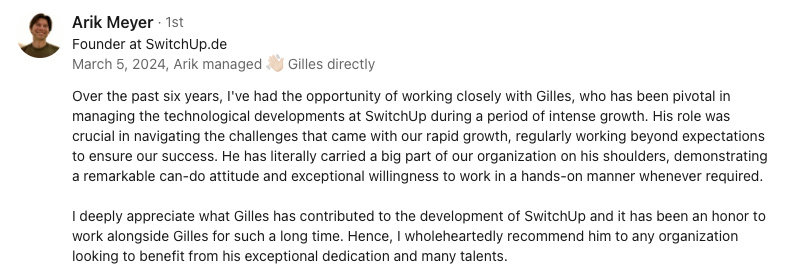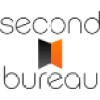Abstract:
The article emphasizes the importance of ensuring visibility for remote employees in the context of a technology-driven organization. It highlights the challenges of creating an inclusive environment in remote work settings and proposes leveraging technology to bridge the gap. The author advocates for the use of purpose-built remote collaboration platforms and regular virtual check-ins to enhance inclusion and visibility for remote employees. These measures aim to facilitate communication, collaboration, and connection, ultimately fostering a culture of transparency, inclusivity, and engagement in the remote work landscape.
Introduction to the importance of visibility for remote workers
Working remotely has gone from a novelty to a norm, especially in technology-driven organizations. It's a trend that's here to stay. As a Chief Technology Officer, I often ponder the unsung hero behind successful remote teams: *visibility*. Many assume 'out of sight, out of mind' applies here. Wrong! Visibility for remote workers isn't just about knowing who's online or available; it's about ensuring they feel seen, integrated, and valued within the company structure.
Why does visibility matter? Let’s break it down: when remote employees aren't visible, they can inadvertently fall behind in professional growth and team integration. It impacts their morale and productivity. Moreover, without clear visibility, recognizing efforts and contributions becomes a Herculean task for managers. Plus, collaboration can falter if team members can’t easily see each other’s work and progress, making it harder to align efforts towards common goals.
While this seems daunting, I'll walk you through the challenges and the all-important solutions that can shine a spotlight on our remote colleagues. From leveraging technology to regular virtual check-ins, there are solid strategies to make everyone feel like a rock star in the band—not just a roadie. So buckle up, we're about to embark (whoops, not that word!)—we're about to roll out an actionable plan that faces these challenges head-on.
Challenges in creating an inclusive environment for remote employees
Maintaining an inclusive environment for remote workers presents an array of challenges that require thoughtful solutions. One of the primary obstacles is communication gaps. Without the benefit of spontaneous office chatter, remote employees can feel out of the loop. It's akin to being left out of a long-awaited movie's spoiler-filled group chat—the connectivity and sense of belonging simply vanish.
The lack of face-to-face interactions is another significant hurdle. When team members don't interact in person, reading body language, facial expressions, and other non-verbal cues becomes impossible. This can lead to misunderstandings or a feeling of detachment. Imagine trying to interpret sarcasm via email—never a good idea!
Isolation is another formidable enemy. Remote workers can often feel like they're on an island, far removed from the camaraderie that a physical office can offer. This sense of isolation can impact their mental well-being and hinder their enthusiasm for the job. I recall a time when a colleague expressed feeling like a ghost in the machine; visible in presence but not in spirit.
Additional barriers to inclusivity for remote teams can include:
- Time zone differences: Coordinating meetings and project timelines across different time zones can make some team members feel like they're playing perpetual catch-up.
- Technological disparities: Not all employees have access to the same quality of technology or internet connectivity, putting some individuals at a distinct disadvantage.
- Lack of opportunities for spontaneous collaboration: The virtual workspace doesn't support those impromptu brainstorming sessions in the break room that can spark innovation.
These barriers are not insurmountable, but they do require a conscious effort to address. And while the journey to inclusivity might feel akin to navigating a maze blindfolded, armed with the right tools and approaches, we can ensure that remote workers aren't just put in the spotlight—they're the stars of the show.
Leveraging technology to enhance inclusivity and visibility
Technology is a game-changer when it comes to bridging the gaps inherent in remote work. Picture it as a Swiss Army knife, packed with tools to tackle various challenges. Let’s explore how we can harness this technology to make our remote workforce feel seen, heard, and connected.
I often find that remote collaboration platforms are the backbone of fostering visibility and inclusivity. These platforms, such as Slack, Microsoft Teams, and Zoom, come with features that promote seamless communication and collaboration. For instance, Slack channels can be dedicated to specific projects or interests, ensuring that everyone stays in the loop without being overwhelmed. The use of emoji reactions and gifs adds a touch of personality, making interactions less robotic and more human.
Features that enhance remote collaboration include:
- Instant messaging: Quick and direct communication channels help clear out misunderstandings and keep everyone on the same page.
- Video conferencing: High-quality video calls enable face-to-face interactions, making it easier to read facial expressions and body language. It’s like bringing a bit of the physical office into the virtual world.
- Document collaboration: Tools like Google Docs and Office 365 allow multiple people to work on a document simultaneously. Real-time edits, comments, and suggestions foster a sense of teamwork and shared goals.
- Project management software: Platforms like Trello and Asana help in tracking progress, assigning tasks, and keeping everyone accountable. When everyone can see the project timeline and who's responsible for what, the team becomes a well-oiled machine.
These tech tools serve more than just practical purposes. They contribute to a sense of belonging and connectedness among team members. Take video calls, for instance. While it might initially feel awkward to hop on a video call, seeing your coworkers’ faces, even virtually, strengthens relationships. It’s like the difference between sending a text versus having a coffee chat.
Let's not forget the importance of asynchronous communication tools, like Loom for video messages or Slack's scheduling feature. These allow flexibility across different time zones, ensuring that everyone can participate without sacrificing their personal time. It's a bit like leaving thoughtful notes for each other without expecting an immediate reply, yet everyone remains aligned.
Ultimately, leveraging technology is about more than just implementing the latest tools; it's about choosing platforms that foster inclusivity, streamline communication, and make everyone feel part of the team. While no tool is perfect, a thoughtful mix tailored to your team’s needs can transform remote work from a solitary endeavor into a collective triumph.
The role of purpose-built remote collaboration platforms
When it comes to elevating the visibility and inclusivity of remote workers, not all collaboration platforms are created equal. Purpose-built remote collaboration platforms can truly be game-changers by addressing the unique needs of remote teams. Let's delve into some key players and their standout features that have made a tangible difference in tech organizations.
First up, there's Slack. This platform is like the Swiss Army knife for team communication. Its channel-based messaging system helps break down communication silos by organizing conversations around specific projects or interests. The delightful use of emojis and gifs injects a bit of personality, allowing team members to connect on a more human level. It’s like gathering around the virtual water cooler, only with more memes.
Next, let's chat about Zoom. Video conferencing with Zoom reduces the feeling of isolation by bringing team faces directly to your laptop screen. Its high-definition video and audio features make it an excellent tool for maintaining those crucial face-to-face interactions. And let’s not forget the joy of virtual backgrounds—who wouldn't want to attend a meeting from the Starship Enterprise?
For collaboration on documents, Google Workspace (formerly G Suite) steps up to the plate. Platforms like Google Docs, Sheets, and Slides enable real-time collaboration, allowing multiple team members to edit and comment simultaneously. It transforms document creation from a solitary task into a group effort, kind of like a virtual brainstorming session.
And how could we overlook Trello? This project management tool uses visual boards, lists, and cards to help teams plan and track progress. It's a fantastic way to keep everyone aligned and aware of who’s doing what, cutting down on the “Who's got this?” confusion. Plus, moving a task from “To Do” to “Done” is oddly satisfying.
There's also Microsoft Teams, which integrates various collaboration tools under one roof, including video calls, messaging, and document sharing. Its tight integration with Office 365 makes it a natural fit for organizations already relying on Microsoft’s suite of products. Everyone can work on the same document in real time, making those “Draft v27_final_FINAL” days a thing of the past.
These platforms do more than just streamline communication and collaboration; they foster a sense of connectedness and teamwork. By choosing the right tools tailored to your team’s needs, you can ensure that everyone feels like a rock star, not just a backup vocalist. And in the world of remote work, that makes all the difference.
Regular virtual check-ins as a strategy for enhancing visibility
Let’s face it: remote work can sometimes feel like being adrift in a sea of emails and task lists. That’s where regular virtual check-ins come into play, acting as life buoys that keep everyone afloat and visible. Think of these check-ins as your team's virtual coffee breaks—without the caffeine jitters but with all the engagement.
Regular virtual check-ins are critical for keeping employees engaged and ensuring everyone’s voices are heard. When team members feel seen and heard, their morale and productivity tend to soar. These check-ins offer a consistent touchpoint where remote workers can share updates, seek feedback, and, crucially, feel included in the team’s rhythm. In essence, they transform the abstract idea of remote work into a tangible and connected experience.
Benefits of regular virtual check-ins
- Enhanced Communication: Consistent check-ins ensure that information flows smoothly, minimizing misunderstandings and keeping everyone on the same page.
- Empowerment: Giving team members a platform to voice their concerns and ideas fosters a sense of ownership and empowerment.
- Early Problem Detection: Regular updates help spot potential issues before they become full-blown crises, enabling proactive problem-solving.
- Relationship Building: Frequent interactions help build rapport and camaraderie, making remote workers feel like part of the team.
Tips for conducting effective virtual check-ins
- Be consistent: Schedule regular check-ins at convenient times for all team members. Consistency helps establish a routine that everyone can rely on.
- Keep it concise: Respect everyone’s time by keeping check-ins focused and to the point. It’s better to have shorter, more frequent meetings than long, infrequent ones.
- Encourage participation: Create an environment where everyone feels comfortable speaking up. Use icebreakers or relaxed questions to get the conversation flowing.
- Use video: Whenever possible, opt for video calls. Seeing each other’s faces adds a layer of personal connection that audio-only meetings lack.
- Follow-up: Summarize key points and action items after the meeting. This helps ensure accountability and keeps everyone aligned.
One success story that comes to mind is from a tech startup where weekly check-ins completely revitalized the team’s dynamics. These check-ins provided a platform where remote employees could share personal updates, discuss challenges, and celebrate wins—big or small. The result? A more cohesive, motivated team that felt genuinely connected despite the physical distance.
So, let’s not underestimate the power of regular virtual check-ins. They are more than mere meetings—they're the glue holding remote teams together, ensuring everyone is not just seen but valued. And hey, who knows, you might even discover your team’s hidden talents for virtual background creativity along the way!
Building a culture of transparency, inclusivity, and engagement
Building a culture where transparency, inclusivity, and engagement are cornerstones is essential for nurturing a thriving remote workforce. These values are not just management buzzwords; they are foundational elements that create a cohesive and motivated team. When remote employees feel they are genuinely part of the company's fabric, their productivity and morale soar.
So, what steps can we take to cultivate such a culture? Let’s dive in.
Leadership practices
Leadership sets the tone. By leading with transparency, we demonstrate that open communication is valued. I make it a point to openly discuss company goals, challenges, and even failures. It's like showing your hand in poker but in a good way. Everyone feels more involved and trusted when leaders share information freely.
- Lead by example: Be open about your own work and challenges. It encourages team members to do the same.
- Foster open communication: Create avenues for team members to voice their ideas and concerns without fear of retribution. This can be as simple as having an anonymous feedback channel.
Company policies
Policies play a significant role in shaping culture. Inclusive policies that promote work-life balance, accommodate different time zones, and recognize diverse contributions create a more equitable workplace.
- Flexible working hours: Allow employees to choose hours that suit their schedules, especially those in different time zones.
- Diversity and inclusion training: Invest in ongoing education to raise awareness and foster a more inclusive environment.
- Transparent career paths: Clearly outline growth opportunities and criteria for promotions. It’s like having a treasure map where the 'X' actually marks the spot.
The role of technology
Technology is a powerful enabler of transparency and inclusivity. Using the right tools can make a massive difference.
- Centralized communication platforms: Use tools like Slack and Microsoft Teams to ensure everyone stays in the loop. Public channels where most conversations happen keep information accessible to all.
- Regular updates and dashboards: Tools like Asana or Jira provide visibility into project statuses, ensuring everyone knows what's happening and who’s responsible for what.
- Interactive town halls: Use platforms like Zoom for monthly all-hands meetings where top leadership shares updates and answers questions in real-time.
The benefits of building such a culture extend far beyond enhanced productivity. It cultivates loyalty, improves job satisfaction, and reduces turnover rates. A team that feels seen, heard, and valued is more likely to be passionate about their work and contribute beyond expectations.
So, it may take conscious effort and time but fostering a transparent, inclusive, and engaged culture pays dividends. It's like planting a tree—the best time to do it was years ago, but the second-best time is now. Let's make sure our remote workers are not only in the room but are a vibrant part of the conversation.
Conclusion: Recap and lasting impact of enhancing visibility
Reflecting on our exploration of visibility for remote workers, it’s clear that ensuring our distant colleagues feel integrated and valued is vital for the health of our organizations. We started with the idea that visibility isn't just about who's online; it’s about making every team member feel seen and appreciated, regardless of physical location.
We identified several challenges to inclusivity in remote work, such as communication gaps, isolation, and technological disparities. These hurdles can make remote employees feel like they’re playing a never-ending game of catch-up. Yet, as we discovered, technology can act as a bridge. Tools like Slack, Zoom, Google Workspace, and Trello transform remote dynamics, fostering connectivity and collaboration.
Furthermore, purpose-built remote collaboration platforms offer unique features that enhance team visibility and engagement. Whether it’s organizing conversations around specific projects or enabling real-time document collaboration, these platforms bring a bit of the office buzz into the virtual world.
Regular virtual check-ins also emerged as a powerful strategy. These routine touchpoints ensure that every voice is heard, creating a sense of belonging and alignment within the team. They might even reveal hidden talents for creative virtual backgrounds!
Finally, we looked at building a culture steeped in transparency, inclusivity, and engagement. Leadership practices, inclusive company policies, and the right use of technology are all instrumental in nurturing such an environment. By doing so, we not only boost productivity but also cultivate loyalty and job satisfaction across the team.
So, what’s the lasting impact? Enhancing visibility for remote workers goes beyond productivity—it’s about creating a connected and valued team, ready to tackle any challenge. As the management expert Peter Drucker once said, “The best way to predict the future is to create it.” By shining a spotlight on our remote teams, we create a brighter, more inclusive future for everyone.
You might be interested by these articles:
- Innovation at Scale: Balancing Speed and Stability in Tech Development
- Mental Health in Remote Work
- Authenticity: The Secret to Startup Success





